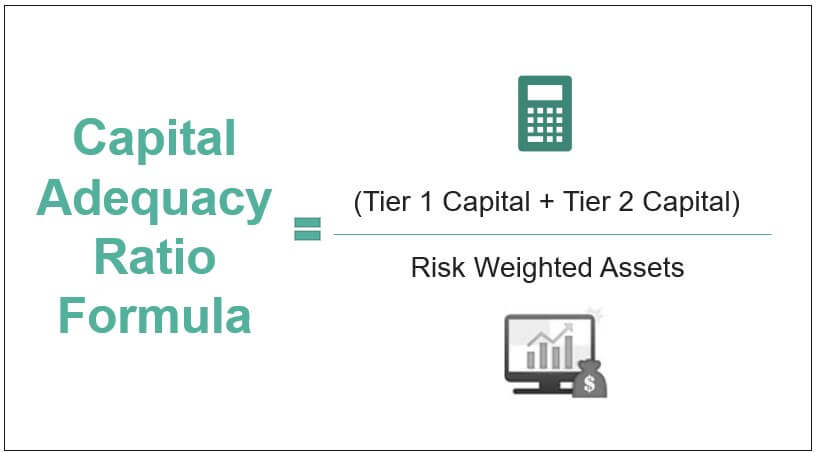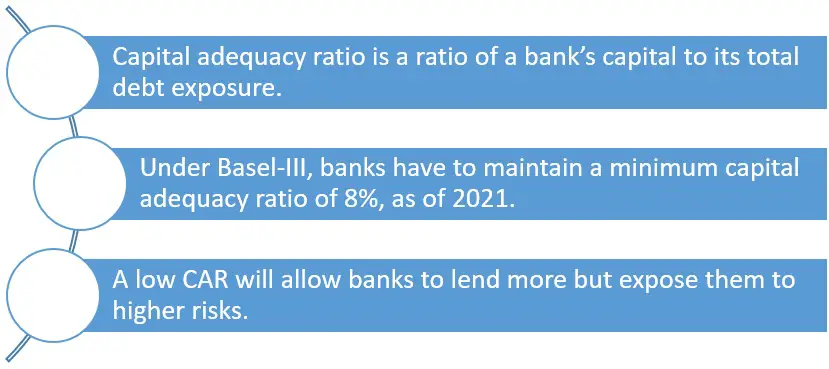The Capital Adequacy Ratio (CAR) is a vital metric used to gauge banks’ resilience in absorbing losses and their capacity to manage liabilities and address credit and operational risks. Regulators employ it to evaluate a bank’s resilience to losses. A higher CAR signifies greater capacity to endure losses, translating to lower risk for the bank.
Basel III regulations mandate an 8% Capital Adequacy Ratio (CAR). However, Indian public sector banks must uphold a higher CAR of 12%, while Indian scheduled commercial banks must maintain a CAR of 9%.
The Capital Adequacy Ratio (CAR) formula
CAR = (Tier 1 capital + Tier 2 capital)/risk weighted assets

Tier 1 and Tier 2 Capital
- Tier 1 capital comprises common equity, retained earnings, and specific hybrid capital.
- Tier 2 capital supplements Tier 1 during crises.
The Importance of Capital Adequacy Ratio (CAR)
The Capital Adequacy Ratio (CAR) is important in banking and financial stability. It serves several crucial purposes that contribute to the overall health and resilience of the banking sector and the broader economy:
- Preventing Excessive Leverage: Central banks and financial regulators establish CAR requirements to prevent commercial banks from taking on excessive leverage. This measure safeguards against situations where banks become highly indebted and vulnerable to insolvency due to risky investments or financial downturns.
- Protecting Depositors’ Funds: CAR is essential for ensuring that banks maintain a buffer to absorb losses before reaching a state of insolvency. This protection is vital because depositors’ funds are prioritized over the bank’s capital in the event of a bank winding up. A higher CAR ensures that depositors’ savings remain secure even if the bank faces losses.
- Indicator of Financial Health: A bank with a high CAR is financially sound and healthy. It signifies that the bank possesses a robust capital base, which enhances its ability to meet financial obligations, including repaying depositors, servicing debts, and sustaining operations.
- Risk Mitigation: CAR plays a crucial role in mitigating the risk of bank insolvency, which, if widespread, can lead to financial crises and economic instability. By enforcing adequate capital reserves, CAR helps minimize the likelihood of bank failures and their adverse ripple effects on the broader financial system.
- Economic Stability: Ultimately, a stable banking sector underpinned by sufficient capital adequacy contributes to the overall stability of an economy’s financial system. It reduces the risk of bank failures, bank runs, and systemic financial disruptions, promoting confidence among investors, depositors, and the public.
In summary, the Capital Adequacy Ratio (CAR) acts as a fundamental safeguard in the banking industry, protecting depositors’ funds, preventing excessive risk-taking, and fortifying the stability of financial systems and economies. Regulatory authorities establish and monitor CAR requirements to ensure banks balance risk-taking and financial resilience.

M.C.Q.
Prelims
Consider the following statements: (Pre18 Set-D)
1) Capital Adequacy Ratio (CAR) is the amount that banks have to maintain in the form of their own funds to offset any loss that banks incur if the account-holders fail to repay dues.
2) CAR is decided by each individual bank.
Which of the statements given above is/are correct?Answer : 1 only
Non-performing Assets (NPAs) are the loans made by a bank or finance company on which repayments or interest payments are not being made on time. Which among the following is NOT an impact of higher NPAs on the banks in India?
A) Banks tend to levy higher interest rate on future advances.
B) Results in lesser interest income
c) Increase in the share of capital to be set aside and cannot be used for lending
D) Increase in the Capital adequacy Ratio(CAR)Answer : D
